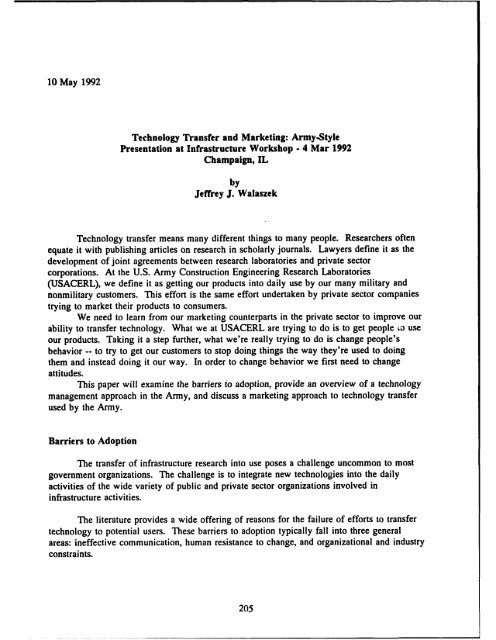Challenges and Opportunities for Innovation in the Public Works ...
Challenges and Opportunities for Innovation in the Public Works ...
Challenges and Opportunities for Innovation in the Public Works ...
Create successful ePaper yourself
Turn your PDF publications into a flip-book with our unique Google optimized e-Paper software.
10 May 1992<br />
Technology Transfer <strong>and</strong> Market<strong>in</strong>g: Army-Style<br />
Presentation at Infrastructure <strong>Works</strong>hop - 4 Mar 1992<br />
Champaign, IL<br />
by<br />
Jeffrey J. Walaszek<br />
Technology transfer means many different th<strong>in</strong>gs to many people. Researchers often<br />
equate it with publish<strong>in</strong>g articles on research <strong>in</strong> scholarly journals. Lawyers def<strong>in</strong>e it as <strong>the</strong><br />
development of jo<strong>in</strong>t agreements between research laboratories <strong>and</strong> private sector<br />
corporations. At <strong>the</strong> U.S. Army Construction Eng<strong>in</strong>eer<strong>in</strong>g Research Laboratories<br />
(USACERL), we def<strong>in</strong>e it as gett<strong>in</strong>g our products <strong>in</strong>to daily use by our many military <strong>and</strong><br />
nonmilitary customers. This ef<strong>for</strong>t is <strong>the</strong> same ef<strong>for</strong>t undertaken by private sector companies<br />
try<strong>in</strong>g to market <strong>the</strong>ir products to consumers.<br />
We need to learn from our market<strong>in</strong>g counterparts <strong>in</strong> <strong>the</strong> private sector to improve our<br />
ability to transfer technology. What we at USACERL are try<strong>in</strong>g to do is to get people ý3 use<br />
our products. Tak<strong>in</strong>g it a step fur<strong>the</strong>r, what we're really try<strong>in</strong>g to do is change people's<br />
behavior -- to try to get our customers to stop do<strong>in</strong>g th<strong>in</strong>gs <strong>the</strong> way <strong>the</strong>y're used to do<strong>in</strong>g<br />
<strong>the</strong>m <strong>and</strong> <strong>in</strong>stead do<strong>in</strong>g it our way. In order to change behavior we first need to change<br />
attitudes.<br />
This paper will exam<strong>in</strong>e <strong>the</strong> barriers to adoption, provide an overview of a technology<br />
management approach <strong>in</strong> <strong>the</strong> Army, <strong>and</strong> discuss a market<strong>in</strong>g approach to technology transfer<br />
used by <strong>the</strong> Army.<br />
Barriers to Adoption<br />
The transfer of <strong>in</strong>frastructure research <strong>in</strong>to use poses a challenge uncommon to most<br />
government organizations. The challenge is to <strong>in</strong>tegrate new technologies <strong>in</strong>to <strong>the</strong> daily<br />
activities of <strong>the</strong> wide variety of public <strong>and</strong> private sector organizations <strong>in</strong>volved <strong>in</strong><br />
<strong>in</strong>frastructure activities.<br />
The literature provides a wide offer<strong>in</strong>g of reasons <strong>for</strong> <strong>the</strong> failure of ef<strong>for</strong>ts to transfer<br />
technology to potential users. These barriers to adoption typically fall <strong>in</strong>to three general<br />
areas: <strong>in</strong>effective communication, human resistance to change, <strong>and</strong> organizational <strong>and</strong> <strong>in</strong>dustry<br />
constra<strong>in</strong>ts.<br />
205







